|
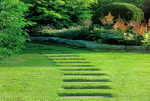 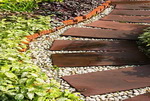 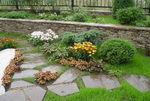
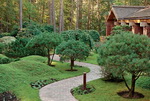 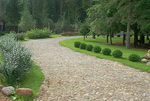 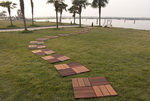
Paths are one of the most important components of any landscape project. They serve not only to perform their function directly, but also are an element of design of a garden. Thus very important things are: covering type and technology of packing. For example, an ideally equal path which has been laid out by concrete tiles, hardly will be pertinent near to landings of beautiful perennials, issued in natural, landscape style.
At the construction of paths it is necessary to choose correctly not only their direction (in order not to split the garden a lot), but also width depending on which the coverage is chosen. Under the path form can be direct or any, natural.
The width of paths depends on their appointment. For example, the basic path leading to the house, has to be in width not less than 1.2-1.5 m for two people could walk there at the same time. The width of minor paths has to be 0.5-1 m.
At roads of any width it is desirable to do a small convex profile to provide a drain of rain water. The bias from an axis to edges becomes no more than 2-3 cm on each meter.
For often used paths are usually used concrete tiles, natural or artificial stone gravel or asphalt. The best material for path is: an artificial or natural stone - the granite, basalt, sandstone, etc. Variety o f colours, sizes, a variety in surface processing (flat, chipped) of stone plates allow to create the most unusual patterns and combinations.
As a material for paths it is possible to use as geometrically correct (square or rectangular), so the free forms of stone plates. The paths which have been laid out by stone plates that are rough and unequal on the size have very beautiful and natural look. If the path is constructed from big stone plates the separate free sites are filled with small natural stones or elimination for more decorative effect.
Depending on size the thickness of a plate can be 5-10cm. The stones have to be flush with the earth surface, therefore before their packing on all the length of a path is dig out a superficial trench. Packing of plates has to be made on a layer of sand which has to be preliminary well leveled and stamped.
Tiles and stones should lie densely on the basis. After packing cracks between them are filled with sand. Quite often in cracks and backlashes are usually landed different grasses which are not afraid to be trampled.
For landing of cultures the cracks between plates should be not less than 10 cm they are filled with the soil mix that is rich with nutrients.
For building the garden paths it is possible to use concrete stones and plates.
Materials from concrete are appreciated far their durability and stability to a cold. Besides they can be made by yourself, at any size, configuration and colour.
Very often in order to give to a concrete plate a more decorative effect, they are made with drawings on the top surface, with impregnations of multi-coloured stones or splinters of rocks. In the latter case concrete tiles are two-layered: the first (bottom) layer – is made of concrete, the second (top) – is made of colour concrete with impregnations of stones. For making concrete tiles are used metal or wooden forms. For making paths in country, is possible to try to use wood. It is better to be used steady, dense breeds of wood, for example, an oak, but in an economic variant it is possible to use less valuable breeds – pine will do too. On seldom used footpaths is possible to leave soil covering.
See also: Tips for Your Garden, Mistakes in Landscape Design, Garden Style, Regular Style
|
